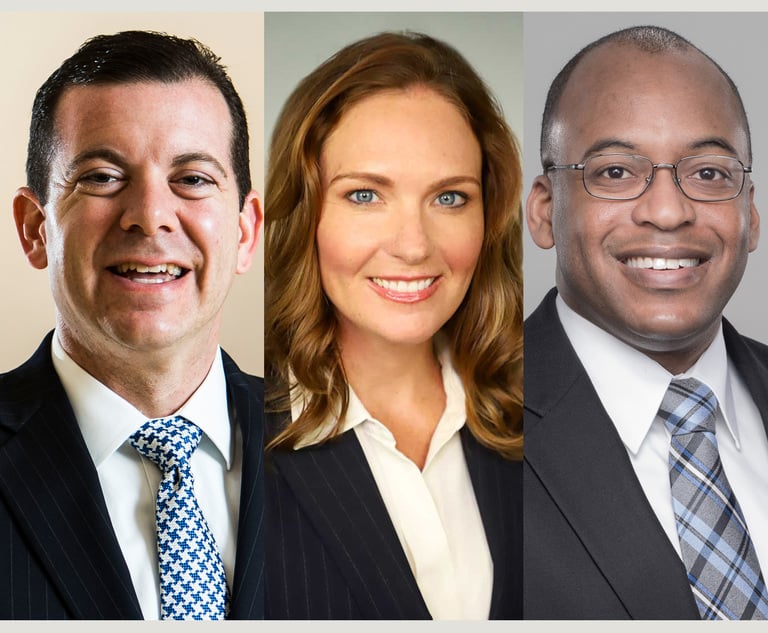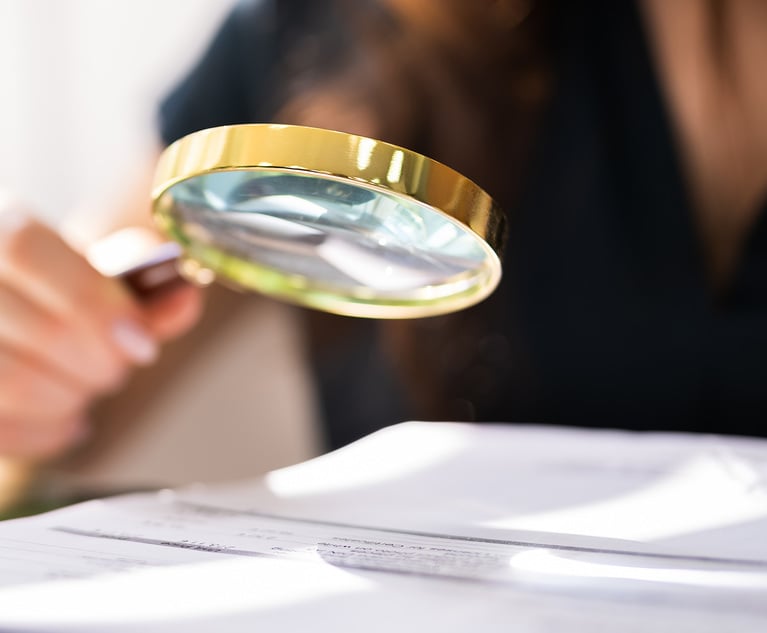Using Modern Techniques for an Age-Old Battle: The Scope of E-Discovery
This article discusses two circumstances in which a litigation cyborg can hold an advantage over a human lawyer when arguing discovery's scope.
April 05, 2018 at 02:04 PM
10 minute read

In May 1997, IBM's Deep Blue defeated grandmaster Garry Kasparov in a highly publicized chess match. The match is cited as the exemplar of the oft-romanticized battle between mankind and machine.
What happened next is not as well known, but perhaps more important for all mankind—including lawyers. Chess champions developed the idea that, instead of pitting humans against machines, they should explore the true heights of chess mastery through man-and-machine teams. The man-and-machine teams came to be known as “cyborgs.”
Flashforward to 2005, when two men disrupted the world of chess cyborgs. Unheralded amateurs Steven Cramton and Zackary Stephen, alongside three of their computers, defeated a tournament pool of cyborg competitors that included teams of celebrated grandmasters and name-brand chess machines.
These historic events in chess teach lessons that have significant application for litigators. Computers cannot match the ingenuity and inventiveness of the human mind. Meanwhile, humans cannot match the calculating power and speed of the computer. When litigators and computers work cooperatively, prior beliefs as to advocacy limitations no longer apply. And that is particularly true for one of the most tried battles waged among litigators: the scope of discovery.
This article discusses two circumstances in which a litigation cyborg can hold an advantage over a human lawyer when arguing discovery's scope. The first concerns the e-discovery plan, which is a counsel-to-counsel agreement encouraged by federal courts as part of a global discovery agreement. The second concerns disputes as to search terms, i.e., the parameters guiding a party's quest to collect discoverable documents. But before either of the two circumstances can be explored, some background is necessary.
General Background on Discovery
E-Discovery is merely one piece of the larger discovery picture. For that reason, it is important to understand the general principles guiding all discovery before diving into the specific principles particular to e-discovery.
Discovery is guided by certain rules. In federal litigations, those rules include the Federal Rules of Civil Procedure, the venue's local rules, the judge's individual preferences, the Federal Rules of Evidence, well-favored secondary sources (e.g., The Sedona Principles), and case law interpreting all of the above.
Those rules set the scope of discovery: “[N]onprivileged matter that is relevant … and proportional to the needs of the case.” Fed. R. Civ. P. 26(b)(1). The factors considered in assessing discovery's scope for a case include: importance of issues at stake in the action; amount in controversy; parties' relative access to relevant information; parties' resources; importance of discovery in resolving issues; whether the burden or expense of discovery outweighs its likely benefit.
Those rules also identify sanctions for failing to either comply with a discovery order or respond to a production request. See, e.g., Fed. R. Civ. P. 37(b)(2)(A).
Specific Principles for E-Discovery
While the general rules discussed above are indisputably applicable to e-discovery, there are specific principles governing e-discovery that must also be noted.
First, electronic documents typically exist in quantities much larger than paper documents. The amount of email correspondence on a typical 2018 day dwarfs that of paper correspondence. The disparity only grows when multiplied for the years-long temporal windows that are applied to most types of litigations.
Second, electronic documents are often dynamic in nature. That is, they are more susceptible to modification than a piece of paper that is created and then stored in a filing cabinet. The dynamics can be visible to the typical lawyer, such as variations of the same Word document that have been marked up through Track Changes. Other dynamics might be invisible to all but a forensic technician, such as modifications to a document's metadata.
Third, the administration of electronic documents can and should be automated within the e-discovery context. Support personnel need not be dispatched to distant warehouses to thumb through files on a folder-by-folder, page-by-page basis. The retrieval instructions in e-discovery are communicated to the platform containing the electronic documents, and the documents are culled, flagged or archived as necessary.
Applying the General Rules and Specific Principles in Two Common Battles
The opportunities to employ a litigation cyborg are growing with each advancement in technology, and may one day overlap all areas of the lawyer's daily activities. For now, I will discuss two areas in which the benefits of a cyborg approach outweigh the apocryphal fears of e-discovery costs.
- The E-Discovery Plan
An e-discovery plan is an agreement among counsel regarding disclosure, discovery and preservation of ESI—including the forms in which it should be produced. See Fed R. Civ. P. 26(f)(3)(C). Though it can be the component of a larger discovery plan, in practice it is typically a standalone document.
A lawyer should never resist entering into an e-discovery plan due to a belief that his is not a “computer-heavy” case. As a preliminary point, it is the rare case where discoverable information only exists on paper and in the minds of witnesses. But most importantly, the e-discovery plan allows all attorneys an opportunity to define the e-discovery footprint at litigation's earliest stage. If an attorney truly believes his case is not “computer-heavy,” then he can craft an e-discovery plan reflecting this belief.
Though e-discovery plans vary from one case to the next, they typically address five themes: (1) the scope of electronic discovery; (2) the searching protocol guiding the collection and review of potentially discoverable documents; (3) the format in which electronic documents will be produced; (4) the manner in which privilege will be addressed; and (5) the approach for dispute resolution regarding any disagreements as to electronic discovery.
Now is the part where the litigation cyborgs (i.e., human attorneys paired with easily-accessible e-discovery software) come in.
Before the plan is finalized, and during its negotiation, a litigation cyborg will have an immense advantage over a run-of-the-mill human. A litigation cyborg can analyze sample collections of vast client data to evaluate the implications of every provision within the e-discovery plan. By contrast, a run-of-the-mill human is forced to make blind assumptions about the volume and dynamics of his data.
Those advantages can impact the litigation's bottom-line costs. See Aguilar v. Immigration & Customs Enf't Div., 255 F.R.D. 350, 358 (S.D.N.Y. 2008) (“[E]arly identification of disputes over the forms of production may help avoid the expense and delay of searches or productions using inappropriate forms.”). For example, an attorney representing the plaintiff-employer in a trade-secret case might blindly agree to review all documents containing the word “confidential.” Such an agreement makes sense in a vacuum. However, a litigation cyborg would know that his email custodian's default signature block contains a notice deeming all emails to be “confidential,” and that it therefore captures all 13,599 emails within the custodian's sent box. The litigation cyborg would also know that, by omitting all emails where the sole reference to “confidential” is within the signature block, he has reduced the documents returned by 96.13 percent.
- Disputes Regarding Search Parameters
Whether in the e-discovery agreement itself or at some point soon thereafter, the parties will address the search parameters expected to guide their respective collections of discoverable ESI. Search parameters are typically expressed through the combination of three variables: (1) custodian; (2) temporal window; and (3) search terms (i.e., a text-based query of the documents maintained by the custodian within the subject temporal window).
Routinely, the parties will disagree as to whether the parameters represent the appropriate scope of discovery. Arguing the scope of discovery is nothing new to attorneys. What is new, however, is how the scope of e-discovery can be litigated. By molding the creativity of the human brain with the computing power of e-discovery software, litigators can make precise arguments on topics that (before cyborgs) could only be expressed via uninformed platitudes.
One old argument that can be made with newfound precision is, “The ratio of relevant documents to reviewed documents is far too small to warrant the discovery demands made.” Cyborgs can state a crisp and precise ratio. They can do so for a vast collection of documents, in a short period of time, at little expense, and can instantly update the ratio as suggested revisions are made to the search parameters.
Courts do not just appreciate the precision of a cyborg's ratio-based approach to parameter disputes—courts are beginning to expect it.
In Fernandez v. Kinrary, No. 13-cv-4938 (E.D.N.Y. Feb. 23, 2017), a collection of plaintiff-employees brought an FLSA action against their alleged employer. The defendant-employer disputed that it exercised a level of control over plaintiffs sufficient to void the independent-contractor label it had applied to them. The plaintiffs demanded defendant's emails in an effort to illustrate this control, and disputed the defendant's position that any email search should be limited to those in which at least one of the plaintiffs was mentioned by name.
The Fernandez court fashioned a straightforward and pragmatic approach. The court ordered the defendant to produce a random sample of 50 emails falling within the plaintiffs' proposed parameters, and advised that the parameters would only be acceptable if at least 25 proved relevant. The court ordered the plaintiffs' counsel to review those emails, identify those it believed relevant, and to present further arguments to the court. The plaintiffs' counsel could only identify 16 emails as potentially relevant. The court ruled that those 16 exhibited questionable relevance at best, and thus denied the plaintiffs' motion to compel production.
Though the Fernandez court allowed the plaintiffs' counsel to spearhead the sample review, in some instances the court itself will tally the relevance ratio. In Vaigasi v. Solow Management Corp., No. 11 Civ. 5088 (S.D.N.Y. Feb. 16, 2016), the plaintiff raised various workplace-discrimination complaints. Following the plaintiff's demand for an extensive number of electronic documents, the court ordered the defendant to provide (for the court's own review) all emails maintained by a particular custodian in which the plaintiff was mentioned by name. This search revealed 178 non-privileged emails. Upon review of those emails, the court ruled that they added nothing of “incremental value.” That is, they either corroborated undisputed facts or addressed irrelevant matters. The court thus ruled that any additional ESI productions would constitute an undue burden upon the defendant.
Conclusion
In a profession as steeped in tradition as the law, it is easy to dismiss newfangled gadgets as inferior to the old-school methods of advocacy. Coordinating the statistical analysis of a client's email inbox, one might say, can never replace looking the client in the eye and asking him the hard questions. That old-school approach creates disputes between man and machine where none exist. It overlooks the opportunity for effective advocacy by teaming old-school intuition with new-school computing.
The game of chess is as old as the practice of law, yet the game's preeminent masters welcomed the opportunity to partner with machines. Lawyers should strive to live by that example, and incorporate technology within their practice as the rule instead of the exception. If amateur chess players can team with computers to defeat grandmasters, then any lawyer who accepts assistance from a computer stands a fighting chance against the country's most prestigious law firms.
Cotton is an associate with Schenck, Price, Smith & King in Florham Park. He works in all facets of sophisticated business litigation, as well as complex construction and condominium litigation.
This content has been archived. It is available through our partners, LexisNexis® and Bloomberg Law.
To view this content, please continue to their sites.
Not a Lexis Subscriber?
Subscribe Now
Not a Bloomberg Law Subscriber?
Subscribe Now
NOT FOR REPRINT
© 2025 ALM Global, LLC, All Rights Reserved. Request academic re-use from www.copyright.com. All other uses, submit a request to [email protected]. For more information visit Asset & Logo Licensing.
You Might Like
View All
After DEI Rollbacks, Employment Lawyers See Potential For Targeting Corporate Commitment to Equality
7 minute read
Topping Kirkland, Weil Won the Most Valuable Major Bankruptcy Retentions of 2024

Fatal Shooting of CEO Sets Off Scramble to Reassess Executive Security
5 minute readTrending Stories
- 1LexisNexis Announces Public Availability of Personalized AI Assistant Protégé
- 2Some Thoughts on What It Takes to Connect With Millennial Jurors
- 3Artificial Wisdom or Automated Folly? Practical Considerations for Arbitration Practitioners to Address the AI Conundrum
- 4The New Global M&A Kings All Have Something in Common
- 5Big Law Aims to Make DEI Less Divisive in Trump's Second Term
Who Got The Work
J. Brugh Lower of Gibbons has entered an appearance for industrial equipment supplier Devco Corporation in a pending trademark infringement lawsuit. The suit, accusing the defendant of selling knock-off Graco products, was filed Dec. 18 in New Jersey District Court by Rivkin Radler on behalf of Graco Inc. and Graco Minnesota. The case, assigned to U.S. District Judge Zahid N. Quraishi, is 3:24-cv-11294, Graco Inc. et al v. Devco Corporation.
Who Got The Work
Rebecca Maller-Stein and Kent A. Yalowitz of Arnold & Porter Kaye Scholer have entered their appearances for Hanaco Venture Capital and its executives, Lior Prosor and David Frankel, in a pending securities lawsuit. The action, filed on Dec. 24 in New York Southern District Court by Zell, Aron & Co. on behalf of Goldeneye Advisors, accuses the defendants of negligently and fraudulently managing the plaintiff's $1 million investment. The case, assigned to U.S. District Judge Vernon S. Broderick, is 1:24-cv-09918, Goldeneye Advisors, LLC v. Hanaco Venture Capital, Ltd. et al.
Who Got The Work
Attorneys from A&O Shearman has stepped in as defense counsel for Toronto-Dominion Bank and other defendants in a pending securities class action. The suit, filed Dec. 11 in New York Southern District Court by Bleichmar Fonti & Auld, accuses the defendants of concealing the bank's 'pervasive' deficiencies in regards to its compliance with the Bank Secrecy Act and the quality of its anti-money laundering controls. The case, assigned to U.S. District Judge Arun Subramanian, is 1:24-cv-09445, Gonzalez v. The Toronto-Dominion Bank et al.
Who Got The Work
Crown Castle International, a Pennsylvania company providing shared communications infrastructure, has turned to Luke D. Wolf of Gordon Rees Scully Mansukhani to fend off a pending breach-of-contract lawsuit. The court action, filed Nov. 25 in Michigan Eastern District Court by Hooper Hathaway PC on behalf of The Town Residences LLC, accuses Crown Castle of failing to transfer approximately $30,000 in utility payments from T-Mobile in breach of a roof-top lease and assignment agreement. The case, assigned to U.S. District Judge Susan K. Declercq, is 2:24-cv-13131, The Town Residences LLC v. T-Mobile US, Inc. et al.
Who Got The Work
Wilfred P. Coronato and Daniel M. Schwartz of McCarter & English have stepped in as defense counsel to Electrolux Home Products Inc. in a pending product liability lawsuit. The court action, filed Nov. 26 in New York Eastern District Court by Poulos Lopiccolo PC and Nagel Rice LLP on behalf of David Stern, alleges that the defendant's refrigerators’ drawers and shelving repeatedly break and fall apart within months after purchase. The case, assigned to U.S. District Judge Joan M. Azrack, is 2:24-cv-08204, Stern v. Electrolux Home Products, Inc.
Featured Firms
Law Offices of Gary Martin Hays & Associates, P.C.
(470) 294-1674
Law Offices of Mark E. Salomone
(857) 444-6468
Smith & Hassler
(713) 739-1250







